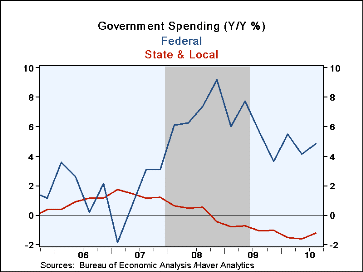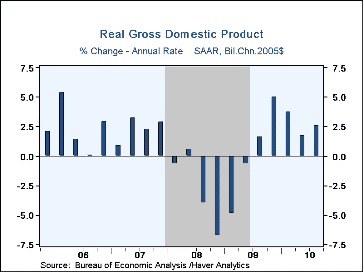 Global| Dec 22 2010
Global| Dec 22 2010U.S. GDP Growth Revised Up; Corporate Profits Lowered
by:Tom Moeller
|in:Economy in Brief
Summary
Real GDP increased 2.6% (SAAR) last quarter which was roughly equal to the preliminary report of a 2.5% rise issued last month. The gain matched expectations for a 2.6% rise by MMS International. So far since the last recession GDP [...]
Real GDP increased 2.6% (SAAR) last quarter which was roughly equal to the preliminary report of a 2.5% rise issued last month. The gain matched expectations for a 2.6% rise by MMS International. So far since the last recession GDP growth has averaged 2.9%, a figure that is less than half the average following other severe, postwar recessions.
The improved GDP growth estimate reflected an upward revision to
inventory accumulation. It now is estimated to have contributed 1.6
percentage points to GDP. In addition, the drag from a deepened foreign
trade deficit was lessened to 1.7 percentage points. Exports grew at an
increased 6.7% annual rate (12.7% y/y) and imports grew at an
unchanged 16.8% rate (16.1% y/y). 
Personal consumption growth was lowered to a modest 2.4% while business investment growth was lessened to 10.0% after a 17.2% Q2 jump. The drop in residential investment was lessened to a still substantial 27.3% which more-than-reversed the Q2 increase. Finally, government spending rose a little-revised 3.9%.
Last quarter's gain in corporate profits was lessened moderately to a weak 1.6% (26.4% y/y). Lower interest rates helped push up financial sector earnings by an improved 10.4% (28.9% y/y). On the other hand, moderate economic growth and weak pricing power reduced nonfinancial sector earnings. They were revised down to no-change from Q2 (37.4% y/y). Profits from the rest of the world fell a slightly deepened 2.3% (+5.0% y/y)
Price inflation as measured by the chained GDP price index was lessened to 2.1% and the 1.2% yearly advance was near the lows of the early-1960s. The personal consumption chain price index rose a lessened 0.8% (1.4% y/y). The price index for fixed business investment rose by 0.2% q/q (-1.0% y/y) and the residential investment price index fell marginally (+0.4% y/y). That compares to a 3.4% decline during all of last year. The GDP figures are available in Haver's USECON and USNA databases and the expectations number is in MMSAMER.
Yield Curve and Predicted GDP Growth from the Federal Reserve Bank of Cleveland can be found here.
| Chained 2005 $, % AR | Q3'10 (Final) | Q3'10 (Prelim.) | Q3'10 (Adv.) | Q2'10 | Q1'10 | Q3 Y/Y | 2009 | 2008 | 2007 |
|---|---|---|---|---|---|---|---|---|---|
| GDP | 2.6 | 2.5 | 2.0 | 1.7 | 3.7 | 3.2 | -2.6 | -0.0 | 1.9 |
| Inventory Effect | 1.6 | 1.3 | 1.4 | 0.8 | 2.6 | 1.9 | -0.5 | -0.5 | -0.3 |
| Final Sales | 0.9 | 1.2 | 0.6 | 0.9 | 1.1 | 1.2 | -2.1 | 0.5 | 2.2 |
| Foreign Trade Effect | -1.7 | -1.8 | -2.0 | -3.5 | -0.3 | -0.9 | 1.0 | -1.1 | 0.7 |
| Domestic Final Demand | 2.6 | 2.9 | 2.5 | 4.3 | 1.3 | 2.1 | -3.1 | -0.6 | 1.5 |
| Demand Components | |||||||||
| Personal Consumption | 2.4 | 2.8 | 2.6 | 2.2 | 1.9 | 1.8 | -1.2 | -0.3 | 2.4 |
| Business Fixed Investment | 10.0 | 10.3 | 9.8 | 17.2 | 7.8 | 8.2 | -17.1 | 0.3 | 6.7 |
| Residential Investment | -27.3 | -27.5 | -29.1 | 25.6 | -12.3 | -5.6 | -22.9 | -24.0 | -18.7 |
| Government Spending | 3.9 | 4.0 | 3.3 | 3.9 | -1.6 | 1.2 | 1.6 | 2.8 | 1.3 |
| Prices | |||||||||
| Chained GDP Price Index | 2.1 | 2.3 | 2.3 | 1.9 | 1.0 | 1.2 | 0.9 | 2.2 | 2.9 |
Tom Moeller
AuthorMore in Author Profile »Prior to joining Haver Analytics in 2000, Mr. Moeller worked as the Economist at Chancellor Capital Management from 1985 to 1999. There, he developed comprehensive economic forecasts and interpreted economic data for equity and fixed income portfolio managers. Also at Chancellor, Mr. Moeller worked as an equity analyst and was responsible for researching and rating companies in the economically sensitive automobile and housing industries for investment in Chancellor’s equity portfolio. Prior to joining Chancellor, Mr. Moeller was an Economist at Citibank from 1979 to 1984. He also analyzed pricing behavior in the metals industry for the Council on Wage and Price Stability in Washington, D.C. In 1999, Mr. Moeller received the award for most accurate forecast from the Forecasters' Club of New York. From 1990 to 1992 he was President of the New York Association for Business Economists. Mr. Moeller earned an M.B.A. in Finance from Fordham University, where he graduated in 1987. He holds a Bachelor of Arts in Economics from George Washington University.










